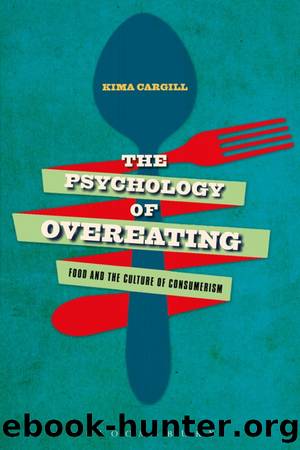The Psychology of Overeating by Kima Cargill

Author:Kima Cargill
Language: eng
Format: epub
Publisher: Bloomsbury Publishing
1Some researchers have challenged this model of de novo lipogenesis and instead argue that dietary carbohydrate is not converted to fat, but instead causes the oxidation of dietary fat which is the pathway to increased fat storage (Hall, 2012; Hellerstein, 1999, 2001).
8
Binge Eating Disorder, the DSM, and Consumer Culture
The Diagnostic and Statistical Manual (American Psychiatric Association, 2013), now in its fifth edition, has been the standard reference text in the mental health field for the past sixty years. Published by the American Psychiatric Association, it catalogs all mental disorders and is used by psychologists, nurses, social workers, and virtually all mental health and medical professionals in the United States, as well as in many other parts of the world. The manual is also used as the basis for undergraduate abnormal psychology classes, training in graduate psychology and psychiatry programs, clinical treatment decisions, and health insurance billing. In addition to this widespread clinical use, the manualâs criteria have been adopted by an extraordinary number of federal organizations and laws such as the National Institute of Mental Health, the Americans with Disabilities Act, the Veterans Administration, prison systems, and education agencies. In short, the ways in which the DSM describes and categorizes mental disorders have far-reaching effects on regulatory efforts, research, and treatment of many health conditions and behaviors, including overeating, overweight, obesity, and addiction.
Eating disorders and the DSM
The previous edition of the diagnostic manual, known as DSM-IV, was used for nearly twenty years until the long-awaited DSM 5 was finally published amid some controversy in 2013. In the earlier DSM-IV, the APA had recognized two distinct eating disorders: Anorexia Nervosa and Bulimia Nervosa. Anorexia Nervosa is characterized by significant underweight (85 percent or less than healthy body weight) and has two diagnostic subtypes: restricting type and bingeing/purging type. Restricting type refers to individuals who engage in severe food or caloric restriction, whereas bingeing/purging type refers to those who engage in episodes of extreme overeating followed by compensatory behaviors such as purging, laxative use, or excessive exercise. Bulimia Nervosa is characterized by binge eating episodes, followed by compensatory behaviors in individuals who are not underweight.1
In other words, there was no diagnosis for binge eating without purging or compensatory behavior; however, a significant literature had emerged on binge eating without purging. Because of the increased scientific recognition of binge eating without purging, which was perhaps in turn due to a population-wide increase of overeating, the DSM 5 Task Force was charged with determining whether people who binge eat without compensatory behaviors were âdisorderedâ in the same or similar way as those diagnosed with Bulimia or Anorexia. After reviewing the research, the task force concluded that the evidence supported a third diagnostic category, and thus Binge Eating Disorder (BED) was codified in 2013.
The DSM now defines Binge Eating Disorder as follows (American Psychiatric Association, 2013):
Download
This site does not store any files on its server. We only index and link to content provided by other sites. Please contact the content providers to delete copyright contents if any and email us, we'll remove relevant links or contents immediately.
What's Eating Us by Cole Kazdin(109)
No Apologies by Niamh Orbinski(91)
Recover from Eating Disorders: The Homeodynamic Recovery Method, Step by Step Guide by Gwyneth Olwyn(77)
The Self-Worth Path: A Guided Journey to an Empowered Life by Papez Lisa(69)
Dancing with a Demon by Valerie Foster(65)
I'm So Effing Hungry by Amy Shah(65)
The Predatory Lies of Anorexia by Abby Kelly(64)
The Psychology of Overeating by Kima Cargill(58)
Hope, Help, and Healing for Eating Disorders by Dr. Gregory L. Jantz(55)
Eat with Joy by Stone Rachel Marie;Wirzba Norman;(52)
Think More, Eat Less by Janet Thomson(51)
A Fat Girl's Manifesto by Cyr V. Daniel(51)
Man Up to Eating Disorders by Andrew Walen(51)
Good Girls: a Story and Study of Anorexia by Hadley Freeman(48)
Lessons from the Fat-o-sphere by Kate Harding(47)
The Parent's Guide to Eating Disorders by Jane Smith(43)
Cognitive-Behavioral Treatment of Obesity: A Clinician's Guide by Zafra Cooper Christopher G. Fairburn Deborah M. Hawker(42)
Body in Mind: a New Look at the Somatosensory Cortices : A New Look at the Somatosensory Cortices by Michael Schaefer(41)
Class Change by MentalCrash(39)
